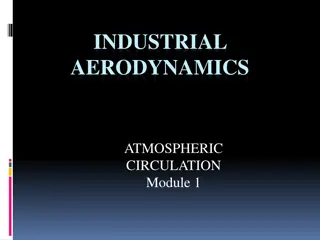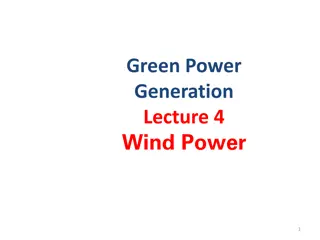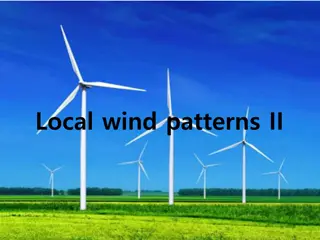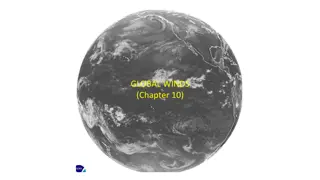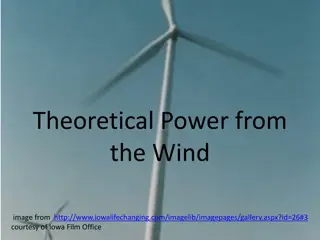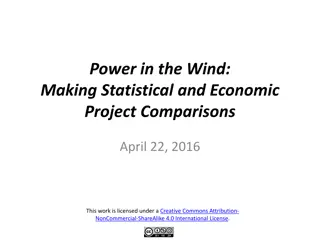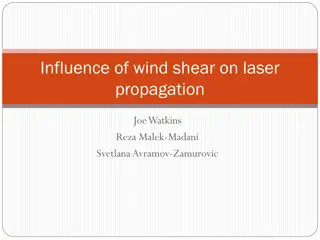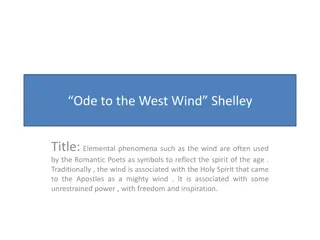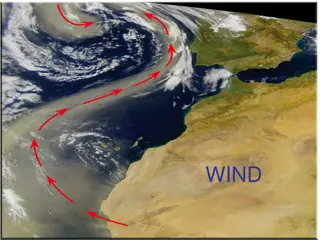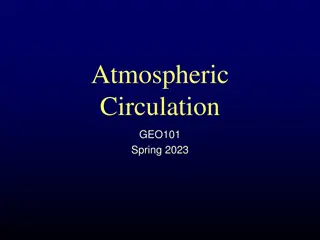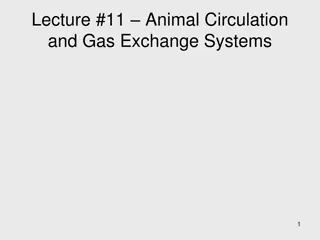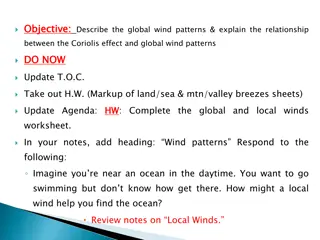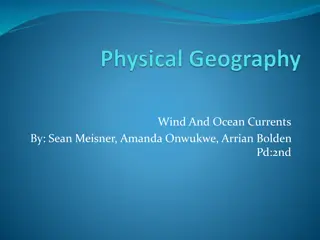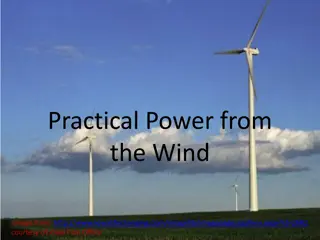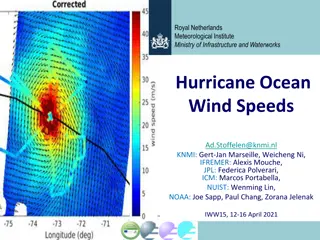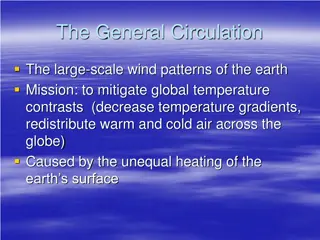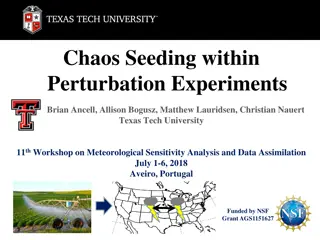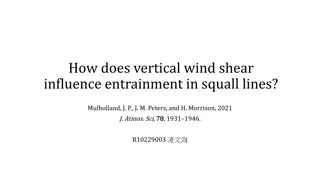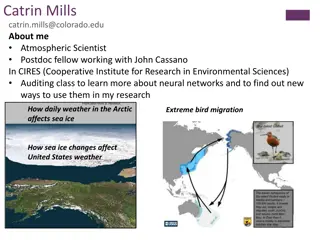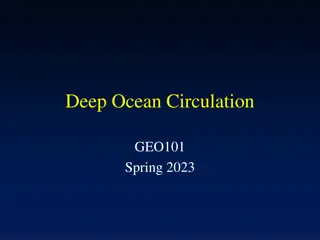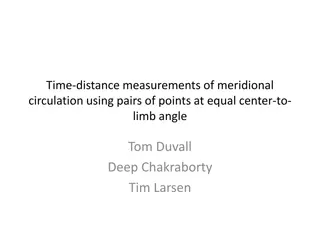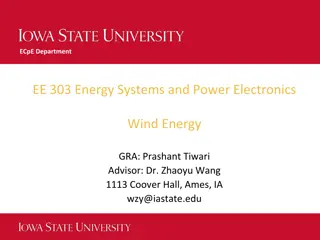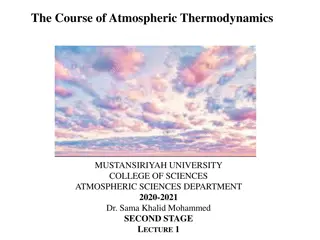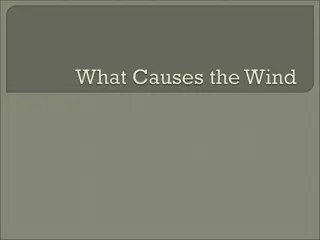Understanding Wind Patterns and Atmospheric Circulation
Wind is the natural movement of air influenced by factors like solar energy absorption, Earth's rotation, and temperature differentials. Local winds arise from small-scale convection currents due to uneven heating. Wind speed changes throughout the day based on air pressure differentials. Monsoons, cyclones, and prevailing winds demonstrate larger-scale wind phenomena.
Download Presentation

Please find below an Image/Link to download the presentation.
The content on the website is provided AS IS for your information and personal use only. It may not be sold, licensed, or shared on other websites without obtaining consent from the author. Download presentation by click this link. If you encounter any issues during the download, it is possible that the publisher has removed the file from their server.
E N D
Presentation Transcript
Wind Wind is the natural movement of air or other gases relative to a earth s surface. Global winds resulting from the difference in absorption of solar energy between the climatic zones on earth. Winds occur on a range of scales, from thunder storms where flows lasting tens of minutes, to local breezes generated by heating of land surfaces and lasting a few hours. The two main causes of large-scale atmospheric circulation are: (i) differential heating between the equator and the poles, (ii) the rotation of the planet (Coriolis effect). Monsoon wind, Sea breeze, Land breezeare are some imp. wind flow.
Local Winds: Small-scale convection currents arise from uneven heating on a smaller scale. This kind of heating occurs along a coast and in the mountains. Small-scale convection currents cause local winds. Local winds blow over a much smaller area and change direction Why do local winds occur? Wind is the horizontal movement of air. The uneven heating of Earth s surface, which sets convection currents in motion, causes all wind. Convection currents on a small scale cause local winds; Convection currents on a large scale cause global winds.
How does wind speed change throughout the day? Air pressure fluctuates across Earth's surface due to differences in altitude. At the Earth's surface, wind blows horizontally from high pressure to low pressure areas. The speed is determined by the rate of air pressure change, or gradient, between the two pressure areas The wind which flows more frequently from one direction than any other is called as Prevailing wind Wind turning clock wise direction is called Veering wind. Wind turning anti-clock wise direction is called Backing wind.
Monsoons Monsoons are like land and sea breezes, but on a larger scale. They occur because of seasonal changes in the temperature of land and water. In the winter, they blow from land to water. In the summer, they blow from water to land. In regions that experience seawater offshore is extremely warm. The hot air absorbs a lot of the moisture and carries it over the land. Summer monsoons bring heavy rains on land. monsoons, the
Low pressure systems or cyclones The word cyclone is derived from a Greek word cyclos meaning the coils of a snake. When the isobars are circular or elliptical in shape, and the pressure is lowest at the centre, such a pressure system is called low or depression or cyclone . A line of low pressure is called a Trough when the isobars are not joined at the ends. In India cyclones occur during the monsoon seasons. The gales accompanying a cyclone give rise to confused seas, torrential rains and usually approach the coast. single severe cyclone can perish hundreds of human lives, animal populations, and submerge thousands of hectares of standing crop.
High pressure systems or anticyclones When isobars are circular, elliptical in shape and the pressure is highest at the centre such a pressure system is called High or Anticyclone . When the isobars are elliptical rather than circular the system is called as a Ridge or Wedge .
Effect of wind on crop plants can be summarized as: Wind affects the plant directly by increasing transpiration, intake of CO2 and causes several types of mechanical damage. Wind helps in pollination and dispersal of seeds. Light and gentle winds are helpful for cleaning the agricultural produce. Hot dry winds frequently do much damage to vegetation in the growing crops by promoting excessive water loss. Wind has powerful effect on humidity. Long, continued warm, dry winds injured blossoms by evaporating the secretion of the stigma. Provides moisture which is necessary for precipitation Wind prevents frost by disrupting atmospheric inversion Causes soil erosion
Sea Breeze: On a hot summer day at the beach, the land heats up faster than the water. The warmer air over land rises, while the cooler air over the ocean rushes in to take its place. This wind is called a sea, or onshore, breeze. Warm air from the land cannot expand into the sea, as the air is cooler and denser, so it expands up into the atmosphere. Cumulus clouds tend to form as the warm air rises over the land to about 500-1500m. Sea breezes can move 70km inland in temperate climates by 9pm in the evening. Sea breezes can be noticed several kilometres out to sea. In the tropics they can be felt 20km from the land. Wind speeds from sea breezes can be about 4-8m/s but can be even stronger
Land Breeze: After sunset, the land cools down faster than the water. The warmer air over the ocean rises, while the cooler air over land rushes in to take its place. This wind is called a land, or offshore, breeze. Land breezes occur at night and in the early morning. The circulation is completed by air rising and moving towards the land at 100-300m. Land breeze affects a small area of 10-15km out to sea, in comparison to the much larger effect of sea breezes. Wind speeds are also lower at 2-3m/s.
A local wind system of a mountain valley that blows downhill (mountain breeze) at night and uphill (valley breeze) during the day is called mountain and valley breeze. During the day, the thin air above the high mountainsides warms quickly. The warm air rises and creates local low pressure along the slopes. mountain & valley breeze
Mountain & valley breeze The most basic differences are the time of day, and direction of the breezes. During day time, the heat coming off the mountain will heat air higher up in the atmosphere at a faster rate then the ground (in the valley). Warm air expands, which creates a small low pressure system at or near the mountain top. In turn, this draws in air from the valley, thus creating a breeze that blows up from the valley to the top of the mountain. The updraft pattern is called valley breeze. At night, the sheer mountain slopes cool down air faster than the existing air in the atmosphere. This creates a localized high-pressure system, as the air becomes more dense and packed in. That high pressure makes winds blow down the mountain into the valley. This downdraft pattern is called mountain breeze.
Mountain & valley breeze
How are sea and land breezes similar to the mountain and valley breezes? Mountain and valley breezes form through a process similar to sea and land breezes. During the day, the sun heats up valley air rapidly. Convection causes it to rise, causing a valley breeze. At night, the process is reversed.


